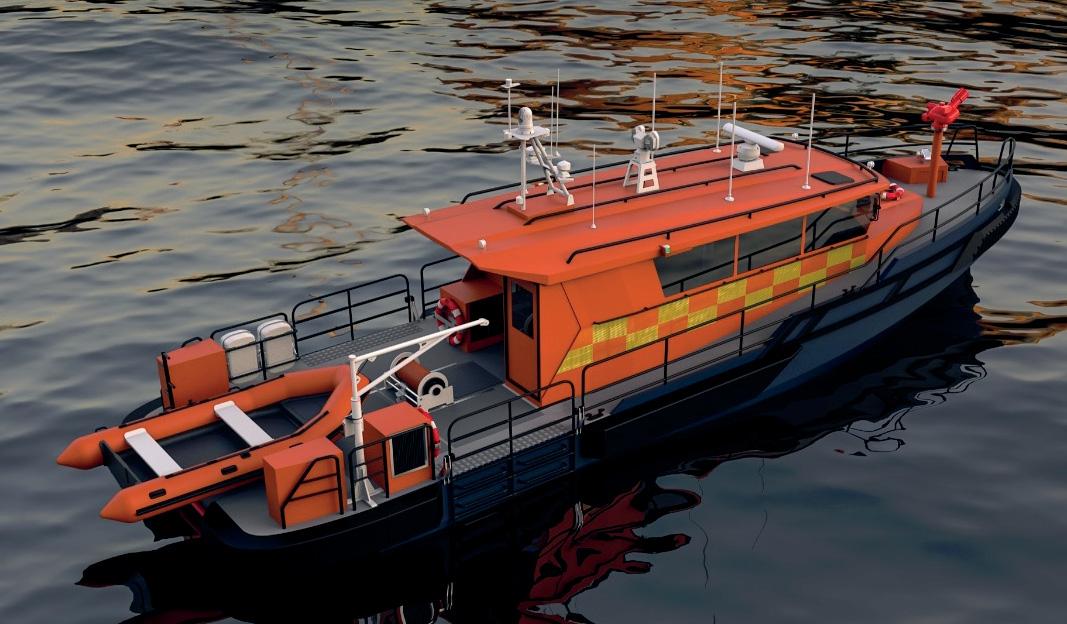
13 minute read
Icelandic SAR
THREE NEW BOATS FOR MARITIME RESCUE ASSOCIATION
The Icelandic Search and Rescue Association (ICE-SAR, Slysavarnafélagið Landsbjörg) has ordered three Search- and Rescue vessels from a Finnish builder
In addition, the agreement, with Kewatec, also includes an option for ten additional boats. The value of the contract for the three boats is approximately EUR 5.7 million and the total value of the entire acquisition is approximately ISK 3.7 billion (EUR 25 million).
The contract was digitally signed by both parties via remote connections on 1 July 2021. The ceremony for the signing of the contract will take place in August this year, when all the parties involved in the project will meet in Iceland and celebrate this major milestone.
The vessels are approximately 17 metres long, fast, selfrighting Kewatec Serecraft SAR17 Search- and Rescue vessels. Their construction will begin in Kokkola at the end of October, the first vessel will be delivered at the end of June next year, the second at the end of next year and the third in the third quarter of 2023.
The renewal of the three ships will cost approximately EUR 5.7 million. Half of the project is covered by the Icelandic State. In addition, 10 vessels are planned to be renewed in the fleet in the next few years, as options in this agreement.
“We are really happy that we have finally reached this stage, when the contract has been signed and the big project will get started,” said Örn Smárason, Project Manager Maritime SAR from ICE-SAR. “At the same time, we look forward to the next phase when we get to build ships,” he continues. “Congratulations to all of us and many thanks to Kewatec for being very effective in completing the agreement.”
Search and Rescue Association Slysavarnafélagið Landsbjörg, ICE-SAR is a national association of rescue units and accident prevention divisions. Its member organisations include 99 rescue units, 70 accident prevention units, women’s sections and 50 youth units. The association has a total of approximately 10,000 volunteers and operates in most Icelandic cities.
8 Kewatec Serecraft
SAR17 Search and Rescue vessel
Navigational simulator feat
A navigational simulator has become the fi rst interactive ‘instructor-led’ cloud training solution to gain new DNV Class D certifi cation.
Wärtsilä Voyage’s NTPRO (Navi-Trainer Professional 5000) navigational simulator has attained certification according to the new DNV Class D standard for cloud-based simulators — making it the first certified cloud solution that offers both interactive instructor-led and student-led training.
With this, the navigational simulator now has full compliance (Class A, B, C, D) with DNV’s ST-0033 Maritime Simulator Systems standard.
“The Class D cloud simulator standards are essentially the same as the Class C classroom simulator standards,” said Johan Ekvall, head of product, simulation and training at Wärtsilä Voyage. “Since we use
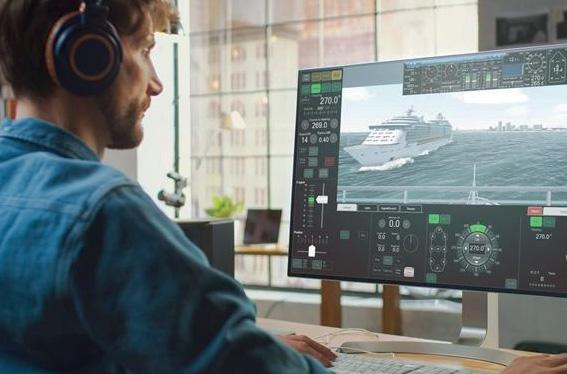
Photo: Wärtsilä Voyage
the same technology platforms in our Cloud Simulation solutions as we do for physical classroom Class C simulators, and provide both instructor-led as well as self-directed exercises, we already had all the necessary functional to meet and exceed the simulator standards for STCW as well as more advanced training applications.”
8 Wärtsilä Voyage’s NTPRO navigational
simulator now has DNV Class D certifi cation
Wärtsilä Cloud solutions are certified to provide both the interactive exercise control required for mandatory (STCW) training and examination, as well as the self-directed detached exercise and assessment that can be undertaken to enhance or supplement Instructor controlled simulations. Together these simulation solutions and associated value-added services equip the training providers with all the tools needed to develop effective and targeted blended learning courses that can be considered for flag or other industry approvals.
“The new standard for cloud training only further facilitates realisation of the value created by remote simulation and learning,” added Ekvall.
AI NOW DEALING WITH REAL MAYDAY CALLS
Since June 21, Sweden’s sea and air rescue leaders have been trialling an artifi cial intelligence solution that monitors Mayday calls
The new system, that monitors emergency calls in the Baltic Sea and around the Swedish coast, is now being used in live tests, and assists the rescue leader in identifying emergency calls by means of AI and Machine Learning.
The tests are underway within the framework of the Heimdall Innovation Project, which aims to develop functional AI technology to gain assistance with intercepting and interpreting incoming emergency calls and presenting them in an operator-friendly interface. The idea is that of Tobias Nicander, a rescue leader at the Swedish Maritime Administration’s sea and air traffic control centre, who had experienced work-induced stress and wanted better technical support to facilitate the operator.
“It feels tremendously satisfying that we can now conduct live tests using real emergency calls; I see great potential for the application. In sea and air rescue, it is a major advantage to gain technical support as a complement to the human ear, ” said Nicander.
The Swedish Maritime Administration’s sea and air traffic control centre JRCC in Gothenburg, Sweden, works around the clock throughout the year to assist those in distress and lead rescue efforts at sea and in the air. Interception depends on the operator’s ability to perceive the individual emergency call that is often made via a radio transmission with low audibility. If the system detects an emergency call, this is noted in the operator’s interface. During the current stage of the project, the Heimdall system will be tested on emergency calls that the rescue leaders observe through interception designed to calibrate and further improve reception.
The company Tenfifty is responsible for the technical AI input in the project.
“Technology designed to convert speech to text using neural networks has made immense strides in recent years and it is extremely pleasing to be able to use technology for social benefit”, says David Fendrich, CTO at Tenfifty.
Maranics AB is responsible for building user interfaces within the project and creating the data capture that goes beyond speech-to-text such as data on weather, ship information and position. The solution is based on pilots that the company has implemented and tested together with the DNVGL classification society.
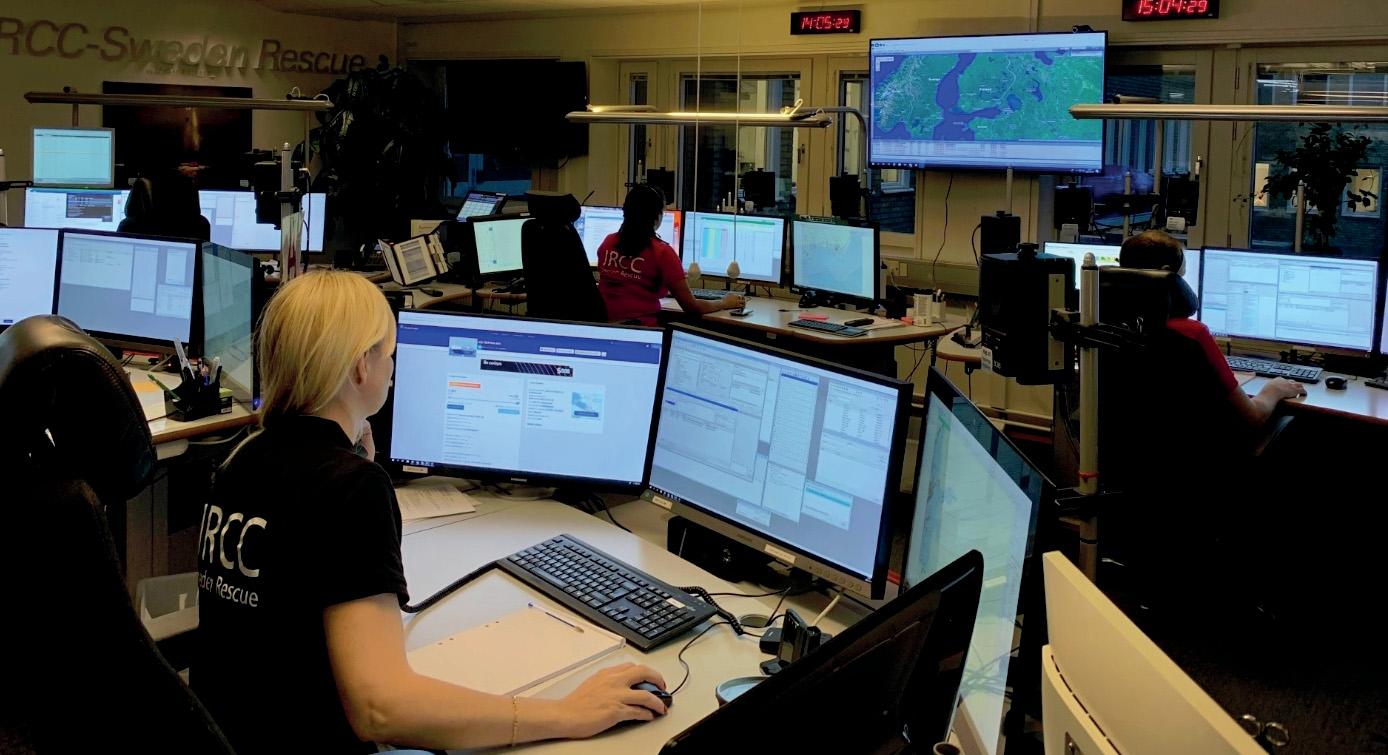
8 The tests are
underway within the framework of the Heimdall Innovation Project
Safety net falls
Shipping stakeholders using satellite signals have been issued a warning.
On 25 June, the UK withdrew from the EU’s EGNOS Safety of Life service and the EGNOS Working Agreements (EWAs), thereby losing the associated legal indemnity for users. There has been no change to the data transmitted by EGNOS satellites.
“The UK’s precipitous withdrawal from statutory agreements on the use of the European satellite overlay system EGNOS will adversely impact several transportation systems” warned Cynthia Robinson, president of the Royal Institute of Navigation.
She explained: “The recent withdrawal of the legal indemnity for aviation EGNOS use in the UK could ultimately affect ships, autonomous vehicles and Beyond-VisualLine-Of-Sight (BVLOS) drones as well, unless a replacement solution can be secured quickly.
“The shipping industry will need to consider appropriate solutions for UK waters as future maritime EGNOS Safety-of-Life services will no longer be made available to the UK in 2023. Possible future wider EGNOS V3 SoL services overlaying GPS and Galileo will also be denied to the UK.”
She concluded: “The Royal Institute of Navigation is working closely with the UK government on the implications of the loss of the EGNOS augmentation Safety of Life services, as well as advising on how best to build resilience, integrity and improved security into the positioning and navigation technologies that affect just about every aspect of our modern lives.”
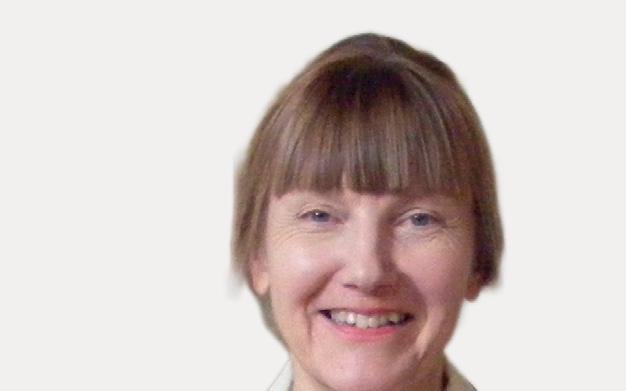
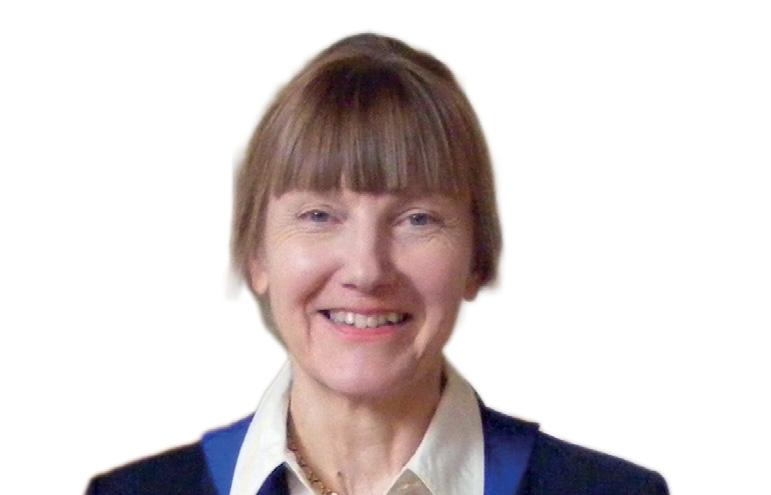
8 Cynthia Robinson: hia Robinson:
”The shipping industry hipping industry will need to consider ed to consider appropriate solutions priate solutions for UK waters...” waters...”
HYDROGEN PROJECT SUPPORT
A spot in the Scottish Highlands is the ideal home for the UK’s largest green hydrogen electrolyser, according to a feasibility study
The North of Scotland Hydrogen Programme ‘Distilleries Project’ study examined the feasibility of the Programme’s plan for a green hydrogen hub in the Cromarty Firth that will supply distilleries in the region with hydrogen at a competitive price to help decarbonise their heating and processes in making whisky. The study identifi ed multiple sites around the Firth deemed fi t to host a 35MW electrolyser facility by 2024, producing up to 14t of green hydrogen per day.
Bob Buskie, chief executive of the Port of Cromarty Firth, one of the programme partners, said: “This is fantastic news for both the Cromarty Firth and for the country’s ambitions to become a leading hydrogen nation, with targets for Scotland to generate 5GW of renewable and low-carbon hydrogen by 2030 - enough to power the equivalent of 1.8 million homes.
“Phase 1 of the electrolyser could be up and running, and the first hydrogen produced, by 2024 in what will be one of the biggest electrolysers in the UK. Such a facility will be a game changer not only for industries across the Highlands and Scotland, but also for the UK and internationally as we will be able to export green hydrogen to energy markets around the globe.”
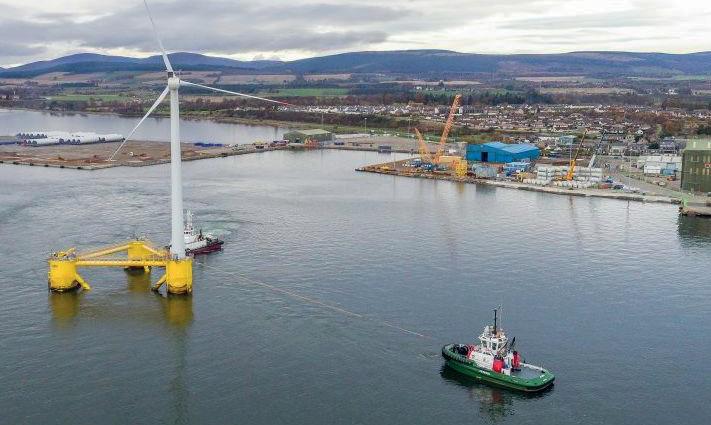
RENEWABLE ENERGY POTENTIAL
The report said the Cromarty Firth’s suitability was boosted by a large regional concentration of renewable energy potential, including future offshore wind development sites which would be able to supply the volume of clean electricity needed for the electrolyser.
Coupled with this substantial offshore wind resource is an already significant existing infrastructure in the Cromarty Firth, as well as a proven track record of success in renewables, an experienced local supply chain and extremely strong links to industry, transport and heat networks.
The study proposes a phased development for the facility. Phase 1 would see the electrolyser in place by 2024 to meet local and distillery demands and to prove the technology at this scale. A second phase would lead to an expansion of green hydrogen to meet growing energy demands nationally and internationally.
The project will now move into its next stage of development, to include detailed engineering, community engagement and commercial development. A final investment decision will be made by 2023.
The study was backed by partners including ScottishPower, Pale Blue Dot (A Storegga Group Company), Port of Cromarty Firth, and drinks giants Glenmorangie, Whyte & Mackay and Diageo.
8 green hydrogen
hub in the Cromarty Firth could produce up to 14t of green hydrogen per day
Award winning roadmap
Port of Tyne welcomed the Rt Hon Anne-Marie Trevelyan MP, UK Minister of State for Business, Energy and Industrial Strategy recently.
The Minister took a tour around the Port’s estate to view several sites earmarked for green energy development and discuss progress on the Port’s award-winning clean energy roadmap, part of its ambitious ‘Tyne 2050’ strategy.
Tyne Clean Energy Park offers a high degree of flexibility for the offshore wind supply chain and, during her visit, the Minister was able to see the preparatory works underway for the Park’s first tenant, Equinor, who are building the operations and maintenance base for the world’s largest offshore windfarm - Dogger Bank, a joint venture between Equinor, SSE Renewables
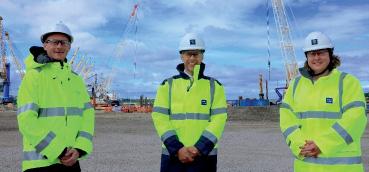
8 L-R Tom Nightingale, Equinor; Matt Beeton,
Port of Tyne; Rt Hon Anne-Marie Trevelyan, Minister of State for Business, Energy and Industrial Strategy
and Eni. The Minister also met with the Port’s CEO, Matt Beeton, and Chair, Lucy Armstrong, to discuss the huge commercial opportunity presented by the offshore wind sector to level up the region and support national economic growth. As part of its Tyne 2050 strategy, the Port also committed to being carbon neutral by 2030 and, just two years later, carbon emissions have already been cut by some 27%.
SHORE POWER SURGE
A major shore power step has been taken at one European port
The onshore power plant at the Port of Kiel’s Ostseekai cruise terminal has been offi cially inaugurated. The 16MW facility is expected to off er savings of approximately 8,000t of CO2 annually and can supply a cruise ship at Ostseekai and a ferry at the Schwedenkai terminal in parallel.
“With this investment, which now enables shore power supply at a total of three locations in Kiel, the seaport should also be very far ahead in international comparison. The plant will save thousands of tonnes of CO2 and thus relieve the people in the state capital considerably,” said Dr Bernd Buchholz, Minister of Economics, Transport, Labour and Technology and Tourism of the State of Schleswig-Holstein.
AIDA Cruises’ AIDAsol was the first cruise ship to be connected to the shore power supply system on 16th June. The ship is to receive shore power in regular operation at Kiel with immediate effect.
The new onshore power plant has also been supplying electricity to Stena Line ferries daily at the Schwedenkai since the beginning of the year. This saves about 5,000 tonnes of carbon dioxide (CO2) per year at the Schwedenkai alone. For every cruise ship that is supplied with shore power, there is an additional saving of about 45t of CO2 on average at the Ostseekai.
In addition, since May 2019, the Color Line ferries at the Norwegenkai have been connected to the shoreside grid, resulting in a further 3,000t less CO2 per year. The state of Schleswig-Holstein supported the construction of the €13.5m plant with about €9m and successfully lobbied at the federal level for a reduction of the EEG apportionment on shore power.
In its first full year of operation, the Port of Kiel plans to supply 70 cruise calls with shore power.
Kiel’s Lord Mayor, Dr Ulf Kämpfer said another onshore power plant is being planned for the Ostuferhafen.
Siemens supplied the core electrical and electronic elements of the onshore power plant. The ShoreCONNECT mobile carrier system for transferring the power cables to the ship comes from Stemmann-Technik, a subsidiary of the Wabtec Corporation.
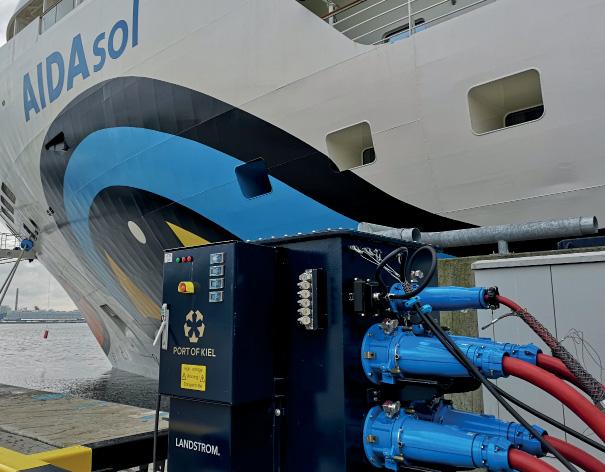
8 AIDAsol was the
fi rst cruise ship to be connected to the shore power system at the Port of Kiel’s Ostseekai terminal
Bespoke tug berth
In a limited time window, Inland and Coastal Marina Systems recently designed and manufactured a bespoke berth for a new tugboat at Port of Portland, UK.
Following its purchase from Sanmar in Turkey, the vessel went straight into dry dock to be painted in her new company colours and arrived in Portland in early April.
With space tight and time short to prepare a berth for the 287T tug, Portland Harbour Authority approached ICMS to design a bespoke solution. To accommodate the new vessel within the existing operational pontoons, and factor in its higher freeboard, ICMS manufactured a unique 21.5m heavy-duty pontoon with a tailor made 750mm freeboard.
Benefitting from the new pontoon’s Glass Reinforced Fibre (Work Surface) decking, the
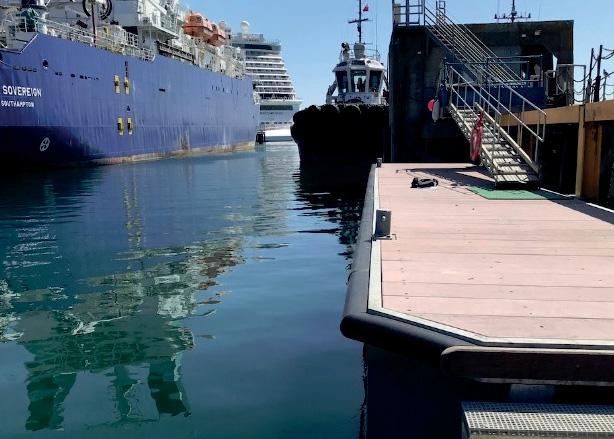
8 The pontoon benefi ts from Glass Reinforced
Fibre (Work Surface) decking
tugboat’s crew will have a durable, anti-slip surface to board the tug from, ensuring safe access all year round, whatever the weather.
“Our heavy-duty pontoons are specifically designed for this type of application as they can be adapted to suit a customer’s specific needs, the location and existing infrastructure,” says ICMS sales manager, Jon Challis.
“Once we’d found the solution and the design was agreed, we worked closely with the Portland Harbour Authority to deliver the new berthing facility on time and on budget, ready for its new tugboat’s arrival.”





